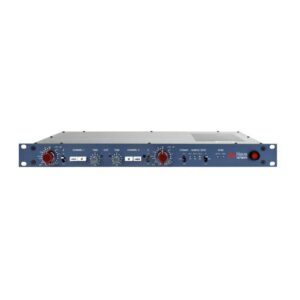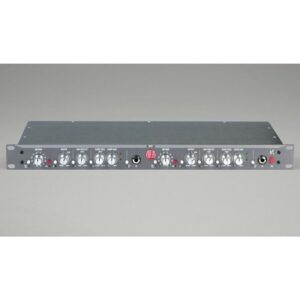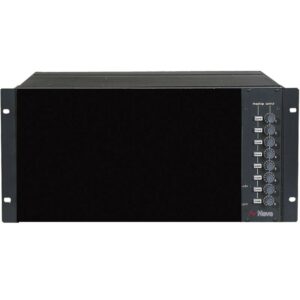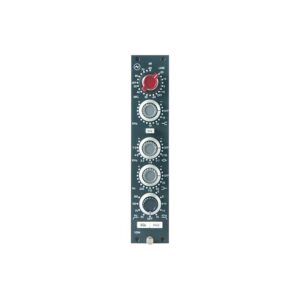Retro Instruments 2A3 Program EQ
True passive 2-channel equalizer with vintage tube amplifiers and custom transformers
$4,795.00
Description
The Retro Instruments 2A3 is an ultra highfidelity, 2-channel program equalizer that not only performs exactly like the industry benchmark Pultec EQ, but also goes it a few frequency sweet spots better.Plus, it has a sub-sonic filter that eliminates the low-frequency problems that can occur with the Pultecs. The Retro 2E3, like the Pultecs that inspired it, also has the unique ability to improve a sound simply by running signal through it. Along with its additional HF frequency centers, Retro has meticulously chosen high-frequency boost circuits that enable the 2E3 to accurately capture the signature sound of the original passive equalizers, which are used to make individual tracks fit into place, vocals shine, and add presence to vocals and instruments. For added versatility, the Retro 2E3 can be used in stereo, dual mono, or cascaded from one channel to the next for additional EQ options on individual sources. Because the Retro Instruments 2E3 passive EQ has the ability to add a lush sonic signature and sweeten any instrument or voice, perhaps it’s most dramatic use is found across the main stereo bus, adding its magic to an overall mix.
Retro Instruments 2A3 Program EQ in one take:
• Industry-standard passive EQ with authentic feel, controls and equalization curves
• Signal-to-noise ratio of greater than 76dB
• Channel separation greater than 70dB
• Frequency response is flat within 1dB from 20Hz-20kHz
• Harmonic distortion is less than 1% from 20Hz-20kHz
• Additional HF boost frequencies for more precise control
• Easily recallable 100-position knob scales on boost and cut controls
• A ganged inter-stage-coupled subsonic high-pass filter provides peaking LF boosts with alternate tonal characteristics
• Transformer-balanced and fullyfloating 600-ohm input and output to eliminate ground-induced hum and noise
• LF boost settings of 20Hz, 30Hz, 60Hz, 100Hz
• Complementary LF cut settings of 20Hz, 30Hz, 60Hz, 100Hz
• HF boost settings of 1.5kHz, 3kHz, 4kHz, 5kHz, 6kHz, 8kHz, 10kHz, 12kHz, 14kHz, 16kHz
• Complementary HF cut settings of 5kHz, 10kHz, 20kHz
• Vintage Class AB tube amplification for unity-gain make-up
• Equalization bypass switches
• Size 2U height: 19″ wide x 3-1/2″ tall x 9″ deep
• XLR input and output connections
• IEC power connector
• 115/230V 50-60Hz switchable AC mains
• Uses readily available 12AX7(2) and 12AU7(2) electron tubes
• Tube substitutions are possible with internal unity gain calibration and jumper selectable 6- or 12-volt tube configuration
• Design minimizes tube heat generation
• High-stability components used throughout
• Steel Chassis built to last
• Manufactured in the USA
• Full factory support
INSIDE THE BOX—Retro Instruments 2E3 Program EQ
The Retro 2E3 derives its sound from vintage Class AB tube amplification for unity-gain make-up, coupled with transformer-balanced and fully floating 600-ohm input and output to eliminate ground-induced hum and noise. The Retro 2A3 passive equalizer circuits do not rely on amplifier feedback, which can cause a harsh and clinical sound, typical of active equalizer designs.
Put simply, there are benefits to having the Retro 2A3 in line without even equalizing, since the tube amplification adds it’s own unique musicality. Like the Pultecs, and one of the reasons they remained at the pinnacle of equalization, the Retro 2E3 improves the sound of audio by merely passing through it. That said, the Retro 2A3 dual-channel tube program equalizer provides a very useful palette of colors and textures for tracking, mixing and mastering. You can use the two channels for stereo, separately on independent tracks, or cascaded from one channel to the next for extended equalization possibilities. (The channel separation exceeds 70dB.)
By incorporating pure passive capacitor/inductor-based equalization, the Retro 2A3 sounds completely natural and effortless—even with extreme boosts and cuts. Retro designer Phil Moore also paid special attention to the Pultec-style bass boost/bass cut technique that is essential to a powerful bass and kick drum EQ. This involves simultaneous low frequency boosts and lower-mid cuts that can scoop out the mud and add real punch. However, with the original Pultecs, low-frequency boosts can bring up subsonic energy that can reduce headroom in digital recordings. (Tape naturally attenuated bass, but in digital, bass is very abundant.) That’s where the 2E3’s subsonic filter comes in.
Subsonic Filter
Unique to the design of the Retro 2AE is a subsonic filter that tame the excessive subsonic energy exhibited in the original design, should bass boosts become overwhelming, or if it’s your artistic choice.Used in concert with the 2AE’s inter-stage transformer, the filter not only reduces the subsonic energy but also provides distinct transformer tonal characteristics for tracking and mixing. The filter has settings of 40Hz and 90Hz with a peaking response and sharp cutoff. The 40Hz setting has no apparent loss of lows as it adds excitement to the 35-40Hz region, which is golden in many listening environments. The smoothing effect of the subsonic filter is apparent throughout the midrange. It is easily switched-out for applications that require tight, accurate low frequency response.
The most common use of the Pultec EQs rests in its application of bass and high frequencies to program material, either on a 2-bus or for parallel drum compression. The Retro 2E3 offers a decided advantage in the midrange, which is very difficult for most equalizers to handle well. However, the Retro 2E3 excels at midrange equalization, which means that midrange content need not be sacrificed with the typical Fletcher-Munson smiley-face EQ, but rather be boosted with the Retro 2E3 to add fullness and depth without having to depend on transformers or bus compressors to restore the midrange that dipping out 500Hz with other equalizers diminishes.
Tube Options
For the tube-sniffing tone snobs among us who require authenticity or more tonal options, the Retro Powerstrip provides the ability to use NOS (new old stock) tubes or new tubes currently in production. Better still, for the less electronically inclined, changing tubes is as simple as plugging them is, since no alignment adjustments are needed.
OUTSIDE THE BOX—Retro Instruments 2E3 Program EQ
The Retro 2A3 incorporates two channels into one 2U space, that features the familiar vintage gunmetal steel chassis of the Retro line, along with its bulletproof construction, stunning good looks, black knobs, toggle switches, and red Retro logo plate. Controls are laid out for ease of adjustment and recallability thanks to precision 100-position knob scales. The front panel controls are arranged in the same configuration as the original classic equalizer, with lowfrequency and high-frequency boost and attenuation controls, low center frequency selector for boost and cut, bandwidth control, and high-frequency boost-cut selector. The front panel toggle switches include channel EQ in and out, subsonic filter select, and power on/off.
The rear panel of the Retro 2E3 has XLR inputs and outputs for each channel and an IEC power connector.
A not widely advertised fact of pro audio is that new equipment isn’t always an improvement over older gear. However, Retro Instruments manages to consistently take the best of iconic studio tools and make them better, while remaining true to the sonics that make the vintage gear so desirable, despite the fact that electronics don’t improve with age. The Retro 2E3 program equalizer is yet another testament to Retro Instrument’s ability to improve on the classic designs without the five-figure price tag for decades-old gear.
Who’s Using Retro Instruments?
Notable users of Retro gear including Grammy-winning and platinum-selling producers and engineers, such as Chris Lord-Alge (Retro 176), Joe Chiccarelli (Retro 2A3), Silvia Massey (Sta-Level), Ross Hogarth (Sta-Level, 2A3), Jacquire King (Retro 176), Michael Brauer (Retro 2A3), Glenn Rosenstein (Retro OP-6, Sta-Level), and many more world-class producer-engineer-mixers and artists.
If you’ve been longing for Pultec sound on your mix, the Retro 2E3 not only nails the sound of classic EQ but also provides a cost-effective alternative thanks to its dual-channel operation. For more information, call or chat with your Westlake Pro audio representative today.
Additional information
| Dimensions | 9 × 19 × 4 in |
|---|
Related products
-
AMS Neve 1073DPD Dual Mic Preamp
$3,150.00Add to WishlistAlready In WishlistAdd to Wishlist-
Add to cart -
AEA RPQ2 2-Channel Preamp
$1,499.00Add to WishlistAlready In WishlistAdd to Wishlist-
Add to cart -
AMS Neve 5U rack & PSU (empty)
$3,990.00Add to WishlistAlready In WishlistAdd to Wishlist-
Add to cart -
AMS Neve 1084 Mono Mic Preamp/EQ (Vertical)
$4,620.00Add to WishlistAlready In WishlistAdd to Wishlist-
Add to cart






